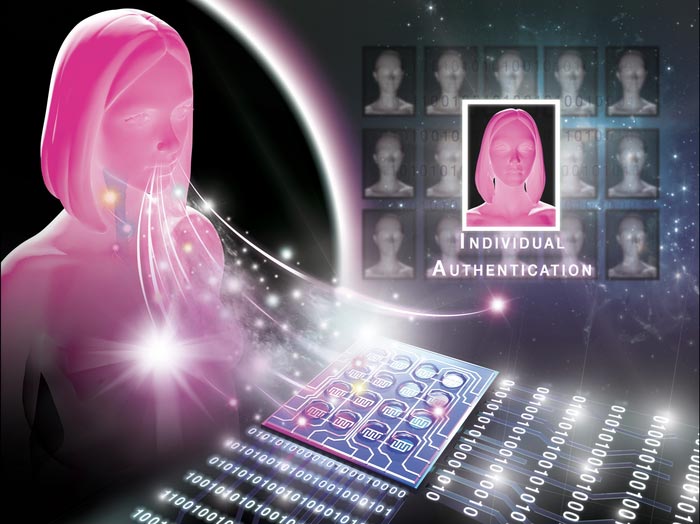Sniffing out your identity with breath biometrics

Breath odor-based individual authentication using an artificial olfactory sensor could become possible in the near future as represented by this artist’s rendering.
Credit: Kyushu University/Yanagida Lab
Researchers develop an olfactory sensor for biometric authentication using your breath.
Biometric authentication like fingerprint and iris scans are a staple of any spy movie, and trying to circumvent those security measures is often a core plot point. But these days the technology is not limited to spies, as fingerprint verification and facial recognition are now common features on many of our phones.
Now, researchers have developed a new potential odorous option for the biometric security toolkit: your breath. In a report published in Chemical Communications, researchers from Kyushu University’s Institute for Materials Chemistry and Engineering, in collaboration with the University of Tokyo, have developed an olfactory sensor capable of identifying individuals by analyzing the compounds in their breath.
Combined with machine learning, this ‘artificial nose,’ built with a 16-channel sensor array, was able to authenticate up to 20 individuals with an average accuracy of more than 97%.
In this age of information and technology, biometric authentication is a critical way to safeguard valuable assets. From the usual suspects of fingerprints, palm prints, voices, and faces to the less common options of ear acoustics and finger veins, there are a variety of biometrics that machines can use to identify you.
“These techniques rely on the physical uniqueness of each individual, but they are not foolproof. Physical characteristics can be copied, or even compromised by injury,” explains Chaiyanut Jirayupat, first author of the study. “Recently, human scent has been emerging as a new class of biometric authentication, essentially using your unique chemical composition to confirm who you are.”
One such target has been percutaneous gas—compounds produced from your skin. However, these methods have their limits because the skin does not produce a high enough concentration of volatile compounds for machines to detect.
So, the team turned to see if human breath could be used instead.
“The concentration of volatile compounds from the skin can be as low as several parts-per-billion or trillion, while compounds exhaled from the breath can go as high as parts-per-million,” continues Jirayupat. “In fact, human breath has already been used to identify if a person has cancer, diabetes, and even COVID-19.”
The team began by analyzing the breath of subjects to see which compounds could be used for biometric authentication. A total of 28 compounds were found to be viable options.
Based on this, they developed an olfactory sensor array with 16 channels, each which could identify a specific range of compounds. The sensor data was then passed into a machine learning system to analyze the composition of each person’s breath and develop a profile to be used to distinguish an individual.
Testing the system with breath samples from six people, the researchers found it could identify individuals with an average accuracy of 97.8%. This high level of accuracy remained consistent even when the sample size was increased to 20 people.
“This was a diverse group of individuals of differing age, sex, and nationality. It’s encouraging to see such a high accuracy across the board,” explains Takeshi Yanagida who led the study.
Nonetheless, he admits that more work is needed before it arrives on your next smartphone.
“In this work, we required our subjects to fast six hours before testing,” concludes Yanagida. “We’ve developed a good foundation. The next step will be to refine this technique to work regardless of diet. Thankfully, our current study showed that adding more sensors and collecting more data can overcome this obstacle.”
For more information about this research, see “Breath odor-based individual authentication by an artificial olfactory sensor system and machine learning,” Chaiyanut Jirayupat, Kazuki Nagashima, Takuro Hosomi, Tsunaki Takahashi, Benjarong Samransuksamer, Yosuke Hanai, Atsuo Nakao, Masaya Nakatani, Jiangyang Liu, Guozhu Zhang, Wataru Tanaka, Masaki Kanai, Takao Yasui, Yoshinobu Babaf, and Takeshi Yanagida, Chemical Communications (2022). https://doi.org/10.1039/d1cc06384g
About Kyushu University
Kyushu University is one of Japan’s leading research-oriented institutes of higher education since its founding in 1911. Home to around 19,000 students and 8,000 faculty and staff, Kyushu U’s world-class research centers cover a wide range of study areas and research fields, from the humanities and arts to engineering and medical sciences. Its multiple campuses—including the largest in Japan—are located around Fukuoka City, a coastal metropolis on the southwestern Japanese island of Kyushu that is frequently ranked among the world’s most livable cities and historically known as a gateway to Asia.
Journal: Chemical Communications
DOI: 10.1039/d1cc06384g
Method of Research: Experimental study
Subject of Research: People
Article Title: Breath odor-based individual authentication by an artificial olfactory sensor system and machine learning
Article Publication Date: 20-May-2022
Media Contact
Raymond Terhune
Kyushu University
sysintlkh@jimu.kyushu-u.ac.jp
Office: 92 802 2443
Original Source
All latest news from the category: Life Sciences and Chemistry
Articles and reports from the Life Sciences and chemistry area deal with applied and basic research into modern biology, chemistry and human medicine.
Valuable information can be found on a range of life sciences fields including bacteriology, biochemistry, bionics, bioinformatics, biophysics, biotechnology, genetics, geobotany, human biology, marine biology, microbiology, molecular biology, cellular biology, zoology, bioinorganic chemistry, microchemistry and environmental chemistry.
Newest articles

Innovative 3D printed scaffolds offer new hope for bone healing
Researchers at the Institute for Bioengineering of Catalonia have developed novel 3D printed PLA-CaP scaffolds that promote blood vessel formation, ensuring better healing and regeneration of bone tissue. Bone is…

The surprising role of gut infection in Alzheimer’s disease
ASU- and Banner Alzheimer’s Institute-led study implicates link between a common virus and the disease, which travels from the gut to the brain and may be a target for antiviral…

Molecular gardening: New enzymes discovered for protein modification pruning
How deubiquitinases USP53 and USP54 cleave long polyubiquitin chains and how the former is linked to liver disease in children. Deubiquitinases (DUBs) are enzymes used by cells to trim protein…



